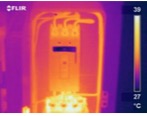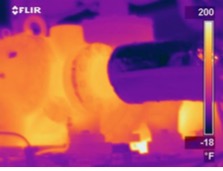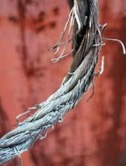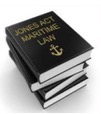Maritime
Maritime Infrared Surveys
Infrared thermography is a recognized test method for condition-based monitoring and predictive maintenance. Shore-based facilities routinely perform infrared inspections to help meet regulatory requirements, reduce operating costs, improve safety, and increase efficiency.
Infrared Surveys performed for the maritime industry provide these benefits for vessels, floating buildings, and offshore platforms. Common maritime applications for infrared thermography include:
- Infrared Electrical System Surveys
- Infrared Mechanical System Surveys
- InfraSonic™ Steam Surveys
- Infrared SOLAS Temperature Surveys
The maritime environment poses unique challenges when performing an Infrared Survey. Jersey Infrared Consultants have extensive experience with vessels and marine installations and carry insurance required for offshore work.
With over 40 years of experience, state-of-the-art equipment, and Level III Infraspection Institute Certified Infrared Thermographers®, Jersey Infrared Consultants can meet all of your infrared inspection needs for your vessels or offshore installations.

Applications
-
Carrier & Container Ships
-
Docks & Floating Buildings
-
Tankers & Cargo Ships
-
Military Vessels
-
Fishing Vessels
-
Tug Boats & Barges
-
Passenger & Merchant Ships
-
Offshore Platforms
Contact us to schedule your Maritime Infrared Survey.
FAQs
Infrared inspections can be applied to a wide variety of systems on vessels and offshore installations.
The most common applications include:
 Infrared thermography is a form of non-contact, nondestructive testing used to detect and document thermal patterns and associated temperatures of electrical system components. Our high-resolution infrared imaging radiometers detect infrared energy emitted from an object and convert it into an image which is displayed on a monitor screen.
Infrared thermography is a form of non-contact, nondestructive testing used to detect and document thermal patterns and associated temperatures of electrical system components. Our high-resolution infrared imaging radiometers detect infrared energy emitted from an object and convert it into an image which is displayed on a monitor screen.
When a component with an unusual temperature is located, the temperature of the problem area is recorded along with the thermal image. The thermogram, control photograph, and problem description are compiled into a report that is available in hardcopy and digital formats.
Typical equipment inspected includes:
- Switchboards
- Circuit Breakers
- Motor Control Centers
- Junction Boxes
- Generators
- Propulsion Equipment
Similar electrical components, operating under similar conditions, should exhibit similar thermal patterns. Unusual thermal patterns typically indicate a potential problem with the subject equipment. Typical problems detected during an Infrared Electrical System Survey include:
- Loose Connections
- Overloaded Circuits
- Unbalanced Loads
- Faulty Equipment
Infrared thermography is a form of non-contact, nondestructive testing used to detect and document thermal patterns and associated temperatures for mechanical system components. Rotating equipment, power transmission units, cranes, and boilers are all candidates for infrared inspection.
Performed regularly, infrared inspections of mechanical systems can help to identify latent or incipient equipment failures.
An InfraSonic™ Steam System Survey combines infrared thermography and contact ultrasonic testing. The result is a comprehensive test which quickly and accurately detects costly, defective steam traps.
 Infrared SOLAS Temperature Surveys help ensure that a ship or vessel complies with SOLAS (Safety Of Life At Sea Regulation 15.2.10. In part this regulation states that “No engine room surface should exceed 220°C.”
Infrared SOLAS Temperature Surveys help ensure that a ship or vessel complies with SOLAS (Safety Of Life At Sea Regulation 15.2.10. In part this regulation states that “No engine room surface should exceed 220°C.”
An Infrared Survey of all surfaces in an engine room can quickly and efficiently identify any surface operating above 220°C and allow for immediate corrective action. A lower temperature threshold, usually 180°C, can be established to identify any surfaces that should be closely monitored.
 Wire ropes and sheaves of onboard and dock cranes can be thermographically inspected to detect increased temperatures or thermal patterns that could indicate potential problems. Cranes may be inspected while in normal operation or they can be inspected with a predetermined weight after operating for a specified amount of time. With the crane in operation, wire cables and sheaves are thermally imaged to detect elevated temperatures or thermal anomalies.
Wire ropes and sheaves of onboard and dock cranes can be thermographically inspected to detect increased temperatures or thermal patterns that could indicate potential problems. Cranes may be inspected while in normal operation or they can be inspected with a predetermined weight after operating for a specified amount of time. With the crane in operation, wire cables and sheaves are thermally imaged to detect elevated temperatures or thermal anomalies.
Sections of wire or sheaves exhibiting thermal anomalies can be marked with paint and documented with a thermal image and a control photograph. These areas can then be investigated to identify the root cause of detected anomalies.
Infrared thermographers must be aware of and comply with numerous safety requirements. These include those published by the American Bureau of Shipping, and the National Fire Protection Association document, NFPA 70E.
Jersey Infrared Consultants personnel are properly trained in the applications and unique safety challenges associated with the maritime industry. For details or to discuss your facility’s specific requirements, please contact us.
 All work performed aboard a ship, vessel, or any structure not supported by solid land (including pilings and platforms) comes under the Jones Act. Specific maritime workers compensation and liability insurance must be obtained with language that addresses the Jones Act.
All work performed aboard a ship, vessel, or any structure not supported by solid land (including pilings and platforms) comes under the Jones Act. Specific maritime workers compensation and liability insurance must be obtained with language that addresses the Jones Act.
Jersey Infrared Consultants is one of the very few infrared firms that have full insurance coverage for maritime inspections.
Jersey Infrared Consultants reports are clear, easy-to-understand, and available in hardcopy and/or digital formats. Your will include the following sections:
- Introduction covers the procedures followed and provides information to assist understanding the report including priority assessment for problems.
- Thermographers Comments will discuss the areas surveyed, number of problems identified and special notation of any serious problems.
- Route(s) that provide a detailed list of all equipment surveyed, including location, type of equipment, identification, status at the time of the survey, and notation of problems along with their severity.
- Deficiencies will be documented with a Thermogram and control photograph, the location of the problem, and a description that includes the following information:
- Equipment name and location
- Ambient temperature
- Temperature rise over similar equipment
- Ammeter readings (where appropriate)
- Detailed comments concerning the problem
- Avoided Cost Analysis based on insurance industry statistics, provides documentation of the potential cost savings associated with our Survey.